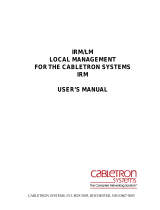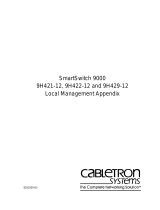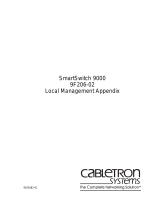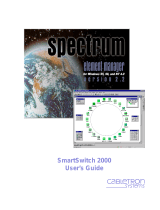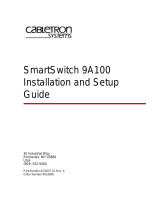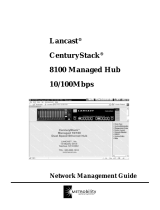Page is loading ...

Title Page
SmartSwitch 7000
User’s Guide


iii
Notice
Cabletron Systems reserves the right to make changes in speciÞcations and other information
contained in this document without prior notice. The reader should in all cases consult Cabletron
Systems to determine whether any such changes have been made.
The hardware, Þrmware, or software described in this manual is subject to change without notice.
IN NO EVENT SHALL CABLETRON SYSTEMS BE LIABLE FOR ANY INCIDENTAL, INDIRECT,
SPECIAL, OR CONSEQUENTIAL DAMAGES WHATSOEVER (INCLUDING BUT NOT LIMITED
TO LOST PROFITS) ARISING OUT OF OR RELATED TO THIS MANUAL OR THE INFORMATION
CONTAINED IN IT, EVEN IF CABLETRON SYSTEMS HAS BEEN ADVISED OF, KNOWN, OR
SHOULD HAVE KNOWN, THE POSSIBILITY OF SUCH DAMAGES.
Virus Disclaimer
Cabletron has tested its software with current virus checking technologies. However, because no anti-
virus system is 100% reliable, we strongly caution you to write protect and then verify that the
Licensed Software, prior to installing it, is virus-free with an anti-virus system in which you have
conÞdence.
Cabletron Systems makes no representations or warranties to the effect that the Licensed Software is
virus-free.
Copyright
1998 by Cabletron Systems, Inc. All rights reserved.
Printed in the United States of America.
Order Number: 9031895-02 July 1998
Cabletron Systems, Inc.
P.O. Box 5005
Rochester, NH 03866-5005
Cabletron Systems
,
SPECTRUM
,
BRIM
,
DNI
,
FNB
,
INA
,
Integrated Network Architecture
,
LANVIEW
,
LANVIEW Secure
,
Multi Media Access Center
,
MiniMMAC
, and
TRMM
are registered
trademarks, and
Bridge/Router Interface Modules
,
BRIM-A100
,
CRBRIM-W/E
,
CRXMIM
,
CXRMIM
,
Desktop Network Interface
,
Distributed LAN Monitoring
,
Distributed Network Server
,
DLM
,
DNSMIM
,
E1000
,
E2000
,
E3000
,
EFDMIM
,
EMM-E6
,
EMME
,
EPIM
,
EPIM-3PS
,
EPIM-A
,
EPIM-C
,
EPIM-F1
,
EPIM-F2
,
EPIM-F3
,
EPIM-T
,
EPIM-T1
,
EPIM-X
,
ESXMIM
,
ETSMIM
,
ETWMIM
,
FDCMIM-04
,
FDCMIM-08
,
FDMMIM
,
FDMMIM-04
,
Flexible Network Bus
,
FOMIM
,
FORMIM
,
HubSTACK
,
IRBM
,
IRM
,
IRM-2
,
IRM-3
,
Media Interface Module
,
MicroMMAC
,
MIM
,
MMAC
,
MMAC-3
,
MMAC-3FNB
,
MMAC-5
,
MMAC-5FNB
,
MMAC-8
,
MMAC-8FNB
,
MMAC-M8FNB
,
MMAC-Plus
,
MRX
,
MRXI
,
MRXI-24
,
MultiChannel
,
NB20E
,
NB25E
,
NB30
,
NB35
,
NBR-220/420/620
,
RMIM
,
SecureFast Switch, SecureFast Packet Switching
,
SFS, SFPS
,
SPECTRUM Element
Manager
,
SPECTRUM for Open Systems
,
SPIM-A
,
SPIM-C
,
SPIM-F1
,
SPIM-F2
,
SPIM-T
,
SPIM-T1
,
TPMIM
,
TPMIM-22
,
TPMIM-T1
,
TPRMIM
,
TPRMIM-36
,
TPT-T
,
TRBMIM
,
TRMM-2
,
TRMMIM
,
and
TRXI
are trademarks of Cabletron Systems, Inc.

iv
AppleTalk, Apple, Macintosh, and TokenTalk are registered trademarks; and Apple Remote Access
and EtherTalk are trademarks of Apple Computer, Inc.
SmartBoost is a trademark of American Power Conversion
ST is a registered trademark and C++ is a trademark of AT&T
Banyan and VINES are registered trademarks of Banyan Systems, Inc.
cisco, ciscoSystems, and AGS+ are registered trademarks; and cBus, cisco Router, CRM, IGS, and MGS
are trademarks of cisco Systems, Inc.
GatorBox is a registered trademark; and GatorMail, GatorMIM, GatorPrint, GatorShare, GatorStar,
GatorStar GX-M, and XGator are trademarks of Cayman Systems, Inc.
CompuServe is a registered trademark of CompuServe Incorporated
X Window System is a trademark of Consortium, Inc.
CTERM, DECnet, and ULTRIX are registered trademarks; and DEC, DEC C++, DECnet-DOS,
DECstation, VAX DOCUMENT, VMA, and VT are trademarks of Digital Equipment Corporation
Fore Systems, ForeRunner, and ForeRunner ASX-100 are trademarks of Fore Systems, Inc.
PC/TCP is a registered trademark of FTP Software, Inc.
HP OpenView is a registered trademark of Hewlett-Packard, Inc.
AIX, IBM, OS/2, NetView, and PS/2 are registered trademarks; and AT, Micro Channel, PC, PC-DOS,
PC/XT, Personal Computer AT, Operating System/2, Personal System/2, RISC System/6000, and
Workplace Shell are trademarks of International Business Machines Corporation
i960 microprocessor is a registered trademark; and Intel and Multichannel are trademarks of Intel
Corporation
Microsoft, MS-DOS, and Windows are registered trademarks of Microsoft Corporation
Chameleon, ChameleonNFS, Chameleon 32, IPX/link, and NEWT are trademarks of
NETMANAGE, Inc.
NetWare and Novell are registered trademarks; and Internetwork Packet Exchange (IPX), IPX, and
Network File System (NFS) are trademarks of Novell, Inc.
Motif and MS are registered trademarks; and Open Software Foundation, OSF, OSF/1, and OSF/Motif
are trademarks of The Open Software Foundation, Inc.
Silicon Graphics and IRIS are registered trademarks; and Indigo and IRIX are trademarks of Silicon
Graphics, Inc.
NFS, PC-NFS, SPARC, Sun Microsystems, and Sun Workstation are registered trademarks; and
OpenWindows, SPARCstation, SPARCstation IPC, SPARCstation IPX, Sun, Sun-2, Sun-3, Sun-4,
Sun386i, SunNet, SunOS, SunSPARC, and SunView are trademarks of Sun Microsystems, Inc.
OPEN LOOK and UNIX are registered trademarks of Unix System Laboratories, Inc.
Ethernet, NS, Xerox Network Systems and XNS are trademarks of Xerox Corporation

v
ANNEX, ANNEX-II, ANNEX-IIe, ANNEX-3, ANNEX-802.5, MICRO-ANNEX-XL, and MICRO-
ANNEX-ELS are trademarks of Xylogics, Inc.
MAXserver and Xyplex are trademarks of Xyplex, Inc.
Restricted Rights Notice
(Applicable to licenses to the United States Government only.)
1. Use, duplication, or disclosure by the Government is subject to restrictions as set forth in
subparagraph (c) (1) (ii) of the Rights in Technical Data and Computer Software clause at DFARS
252.227-7013.
Cabletron Systems, Inc., 35 Industrial Way, Rochester, New Hampshire 03867-0505.
2. (a) This computer software is submitted with restricted rights. It may not be used, reproduced, or
disclosed by the Government except as provided in paragraph (b) of this Notice or as otherwise
expressly stated in the contract.
(b) This computer software may be:
(1) Used or copied for use in or with the computer or computers for which it was acquired,
including use at any Government installation to which such computer or computers may
be transferred;
(2) Used or copied for use in a backup computer if any computer for which it was acquired
is inoperative;
(3) Reproduced for safekeeping (archives) or backup purposes;
(4) Modified, adapted, or combined with other computer software, provided that the
modified, combined, or adapted portions of the derivative software incorporating
restricted computer software are made subject to the same restricted rights;
(5) Disclosed to and reproduced for use by support service contractors in accordance with
subparagraphs (b) (1) through (4) of this clause, provided the Government makes such
disclosure or reproduction subject to these restricted rights; and
(6) Used or copied for use in or transferred to a replacement computer.
(c) Notwithstanding the foregoing, if this computer software is published copyrighted computer
software, it is licensed to the Government, without disclosure prohibitions, with the minimum
rights set forth in paragraph (b) of this clause.
(d) Any other rights or limitations regarding the use, duplication, or disclosure of this computer
software are to be expressly stated in, or incorporated in, the contract.
(e) This Notice shall be marked on any reproduction of this computer software, in whole or in part.

vi

vii
Contents
Chapter 1 Introduction
Using the SmartSwitch 7000 UserÕs Guide................................................................ 1-3
Related Manuals............................................................................................................ 1-4
Software Conventions .................................................................................................. 1-4
Common Window Fields...................................................................................... 1-4
Using the Mouse .................................................................................................... 1-6
Using Window Buttons......................................................................................... 1-7
Getting Help .................................................................................................................. 1-7
Using On-line Help................................................................................................ 1-7
Getting Help from the Cabletron Systems Global Call Center ....................... 1-8
SmartSwitch 7000 Firmware........................................................................................ 1-8
Chapter 2 The SmartSwitch 7000
Chassis View
Viewing Chassis Information ...................................................................................... 2-2
Front Panel Information........................................................................................ 2-4
Menu Structure....................................................................................................... 2-5
Port Status Displays............................................................................................. 2-10
Selecting a Port Status View........................................................................ 2-10
Port Status Color Codes............................................................................... 2-12
The Chassis Manager Window .......................................................................... 2-12
Viewing Hardware Types ................................................................................... 2-13
Device Type ................................................................................................... 2-14
Module Type.................................................................................................. 2-14
Viewing I/F Summary Information.................................................................. 2-15
Interface Performance Statistics/Bar Graphs ........................................... 2-16
Viewing Interface Detail .............................................................................. 2-18
Making Sense of Detail Statistics......................................................... 2-20
Viewing FDDI Statistics ...................................................................................... 2-20
Setting the FDDI Statistics Polling Interval .............................................. 2-21
Using the Find Source Address Feature ........................................................... 2-22
Managing the Hub...................................................................................................... 2-23
ConÞguring Ports ................................................................................................ 2-23
ConÞguring Ethernet and FDDI Ports....................................................... 2-23
ConÞguring Fast Ethernet Ports................................................................. 2-24
Setting the Desired Operational Mode............................................... 2-27
ConÞguring the COM Ports........................................................................ 2-29
Setting the Device Date and Time ..................................................................... 2-31
Enabling and Disabling Ports ............................................................................ 2-32

Contents
viii
Chapter 3 Statistics
Accessing the Statistics Window................................................................................. 3-1
RMON Statistics ............................................................................................................ 3-2
Viewing Total, Delta, and Accumulated Statistics............................................. 3-5
Printing Statistics ...................................................................................................3-6
Interface Statistics..........................................................................................................3-7
Chapter 4 Alarm Configuration
About RMON Alarms and Events..............................................................................4-1
Basic Alarm ConÞguration ..........................................................................................4-2
Accessing the Basic Alarm ConÞguration Window..........................................4-3
Viewing Alarm Status .................................................................................... 4-4
Creating and Editing a Basic Alarm ....................................................................4-6
Disabling a Basic Alarm ........................................................................................ 4-8
Viewing the Basic Alarm Log...............................................................................4-9
Advanced Alarm ConÞguration ...............................................................................4-10
Accessing the RMON Advanced Alarm/Event List.......................................4-10
Creating and Editing an Advanced Alarm.......................................................4-13
Creating and Editing an Event...........................................................................4-19
Adding Actions to an Event ........................................................................4-23
Deleting an Alarm, Event, or Action .................................................................4-25
Viewing an Advanced Alarm Event Log..........................................................4-25
How Rising and Falling Thresholds Work ..............................................................4-26
Chapter 5 FDDI Management
ConÞguration.................................................................................................................5-2
Connection Policy .........................................................................................................5-6
Station List......................................................................................................................5-9
Stations Panel........................................................................................................5-10
Performance ................................................................................................................. 5-11
Chapter 6 ATM Configuration
Accessing the ATM Connections Window ................................................................6-1
ConÞguring Connections.............................................................................................6-4
Adding a New Connection................................................................................... 6-4
Deleting a Connection ...........................................................................................6-5
Index

1-1
Chapter 1
Introduction
How to use this guide; related guides; software conventions; getting help; Smart Switch 7000 firmware
versions
Welcome to the SPECTRUM Element Manager for the SmartSwitch 7000 UserÕs
Guide. We have designed this guide to serve as a simple reference for using
SPECTRUM Element Manager for the Smartswitch 7000 family of hubs.
SPECTRUM Element Manager provides management support for all three
models in the SmartSwitch 7000 family. The 7C03 MMAC SmartSwitch functions
as a chassis within a chassis; residing in an MMAC-series hub, it occupies two
module slots and provides three slots of its own Ñ one for the 7X00 SmartSwitch
Control Module, and two for its own family of Network Interface Modules, or
NIMs. The 7C04 Workgroup SmartSwitch is a stand-alone chassis that offers four
slots: one for the controller, and three for NIMs. The 7C04-R Workgroup
SmartSwitch supplies all the features of the 7C04 along with the additional fault
tolerance provided by a pair of redundant load-sharing power supplies and a
removable fan tray. The 7C04-R can also accept the new double-wide NIM
modules (in slots 3 and 4) for additional front panel connectivity.
TIP
The 7C03 MMAC SmartSwitch chassis provides no network connection to the MMAC
backplane (from which it draws only power). If you wish to connect one or more networks
from the MMAC chassis to the SmartSwitch chassis, you must do so via the front panel
ports available on both the MMAC MIMs and the SmartSwitch NIMs.

Introduction
1-2
At the heart of each SmartSwitch 7000 hub is its 7X00 SmartSwitch Control
Module, which supervises access to the switching backplane and performs all
forwarding, Þltering, and connection management functions; a variety of NIM
modules provide connectivity for FDDI, Ethernet, Fast Ethernet, and ATM
networks. NIM modules currently available include:
¥ The 7E03-24, a single-slot Ethernet module that provides 24 ports via two RJ71
connectors.
¥ The 7E02-24, a double-wide Ethernet module for the 7C04-R which provides
24 ports via RJ45 connectors.
¥ The 7F06-02, which provides connectivity for two FDDI ring networks via its
two front-panel FPIM slots; FPIM modules that support both multi-mode Þber
and single-mode Þber (both with MIC connectors) and both shielded and
unshielded twisted pair (with RJ45 connectors) are available.
¥ The 7H02-06, which provides six Fast Ethernet connections Ñ the Þrst via a
Fast Ethernet Port Interface Module slot, and an additional Þve via built-in
Category 5 UTP RJ45 connectors. Two Fast Ethernet port modules are
available: the FE-100FX, which provides a single multi-mode Þber port with an
SC connector; and the FE-100TX, with a single Category 5 UTP RJ45 connector.
¥ The 7H02-12, a double-wide module which provides 12 Fast Ethernet
connections Ñ the Þrst via a Fast Ethernet Port Interface Module slot, and
another 11 via built-in UTP RJ45s.
¥ The 7H06-02 Fast Ethernet uplink module, which provides two Fast Ethernet
connections via Fast Ethernet Port Interface Module slots.
¥ The 7A06-01, which provides a redundant ATM uplink connection via two
front panel ATM Port Interface Module slots. Available APIMs provide
connectivity for all standard ATM speeds and media types.
The available modules provide your SmartSwitch hub with key mission-critical
features such as redundant links, alarm thresholding, and full error breakdown;
with at least one Ethernet or Fast Ethernet module installed in the chassis,
per-port RMON support is also provided. By default, the 7X00 performs
traditional switching (or bridging); depending on the version of Þrmware you
have installed, the 7X00 module can also be conÞgured to perform CabletronÕs
SecureFast switching.
Note that because the 7C03, 7C04, and 7C04-R provide the same functionality and
support the same family of NIM modules (with the exception of the double-wide
modules, which can be installed only in a 7C04-R), they will be referred to
collectively throughout this manual as the SmartSwitch 7000. Where there are
NOTE
Not all released Þrmware versions support the ability to select SecureFast switching;
check your hardware manuals to see if your version of Þrmware supports this feature.
Currently, the toggle from traditional bridging to SecureFast switching is performed via
Local Management; see your Local Management documentation for details.

Using the SmartSwitch 7000 User’s Guide 1-3
Introduction
differences, however, each device will be named separately, as necessary. Note,
too, that the information displayed in many of the windows will differ slightly
depending upon which type of device is being managed; however, only a single
screen will be shown unless signiÞcant differences in functionality exist.
Using the SmartSwitch 7000 User’s Guide
Each chapter in this guide describes one major functionality or a collection of
several smaller functionalities of the SmartSwitch 7000 hubs and their installed
modules. This guide contains information about software functions which are
accessed directly from the device icon; for information about management
functions which are accessed via the SPECTRUM Element Manager platform,
consult the UserÕs Guide and the Tools Guide.
Chapter 1, Introduction, provides a list of related documentation, describes
certain software conventions, and shows you how to contact Cabletron SystemsÕ
Global Call Center. A brief description of each of the SmartSwitch 7000 chassis
models and the NIMs they support is also provided.
Chapter 2, The SmartSwitch 7000 Chassis View, describes the visual display of
the SmartSwitch 7000 chassis and explains how to use the mouse within the
Chassis View; the operation of several chassis-level management functions Ñ
such as changing the chassis display, enabling and disabling ports, setting device
date and time, and conÞguring ports Ñ is also described here.
Chapter 3, Statistics, describes the two statistics views available at the interface
level: FDDI and ATM interfaces provide MIB-II Interface statistics; Ethernet and
Fast Ethernet interfaces supply RMON statistics.
Chapter 4, Alarm ConÞguration, provides instructions for using both the Basic
and Advanced alarm applications to conÞgure both alarms and the events that
notify you that an alarm condition has occurred. The ability to automatically
initiate a SET or a series of SETs in response to an alarm Ñ functionality provided
by CabletronÕs proprietary Actions MIB Ñ is also described.
Chapter 5, FDDI Management, describes the ConÞguration, Connection Policy,
Station List, and Performance selections available from the FDDI menu.
Chapter 6, ATM ConÞguration, describes how to conÞgure Permanent Virtual
Circuits (PVCs) for any installed ATM modules.
We assume that you have a general working knowledge of Ethernet IEEE 802.3,
Fast Ethernet, ATM, and FDDI type data communications networks and their
physical layer components, and that you are familiar with general bridging and
switching concepts.

Introduction
1-4 Related Manuals
Related Manuals
The SmartSwitch 7000 userÕs guide is only part of a complete document set
designed to provide comprehensive information about the features available to
you through SPECTRUM Element Manager. Other guides which supply
important information related to managing the SmartSwitch 7000 include:
Cabletron SystemsÕ SPECTRUM Element Manager UserÕs Guide
Cabletron SystemsÕ SPECTRUM Element Manager Tools Guide
Cabletron SystemsÕ SPECTRUM Element Manager Remote Administration Tools
UserÕs Guide
Cabletron SystemsÕ SPECTRUM Element Manager Remote Monitoring (RMON)
UserÕs Guide
Cabletron SystemsÕ SPECTRUM Element Manager Alarm and Event Handling
UserÕs Guide
Cabletron SystemsÕ Network Troubleshooting Guide
Microsoft CorporationÕs Microsoft Windows UserÕs Guide
For more information about the capabilities of the SmartSwitch 7000 hub and its
available modules, consult the appropriate hardware documentation.
Software Conventions
SPECTRUM Element ManagerÕs device user interface contains a number of
elements which are common to most windows and which operate the same
regardless of which window they appear in. A brief description of some of the
most common elements appears below; note that the information provided here is
not repeated in the descriptions of speciÞc windows and/or functions.
Common Window Fields
Similar descriptive information is displayed in boxes at the top of most
device-speciÞc windows in SPECTRUM Element Manager, as illustrated in
Figure 1-1 (following page).

Software Conventions 1-5
Introduction
Figure 1-1. Sample Window Showing Group Boxes
Device Name
Displays the user-deÞned name of the device. The device name can be changed
via the System Group window; see the Generic SNMP UserÕs Guide for details.
IP Address
Displays the deviceÕs IP (Internet Protocol) Address; this will be the IP address
used to deÞne the device icon. The IP address is assigned via Local Management
to the 7X00 Control ModuleÕs internal Host interface; it cannot be changed via
SPECTRUM Element Manager. Note that although each interface in the
SmartSwitch 7000 hub has its own MAC, or physical, address, only a single IP
address is assigned.
Location
Displays the user-deÞned location of the device. The location is entered through
the System Group window; see the Generic SNMP UserÕs Guide for details.
MAC Address
Displays the manufacturer-set MAC address associated with the IP address used
to deÞne the device icon; this will be the MAC address assigned to the 7X00
Control ModuleÕs internal Host interface. Note that each interface in the
SmartSwitch 7000 chassis has its own MAC address; these addresses are
factory-set and cannot be altered.
Location
Device
Name
MAC
Address
IP Address

Introduction
1-6 Software Conventions
Using the Mouse
This document assumes you are using a Windows-compatible mouse with two
buttons; if you are using a three button mouse, you should ignore the operation of
the middle button when following procedures in this document. Procedures
within the SPECTRUM Element Manager document set refer to these buttons as
follows:
Figure 1-2. Mouse Buttons
For many mouse operations, this document assumes that the left (primary) mouse
button is to be used, and references to activating a menu or button will not
include instructions about which mouse button to use.
However, in instances in which right (secondary) mouse button functionality is
available, instructions will explicitly refer to right mouse button usage. Also, in
situations where you may be switching between mouse buttons in the same area
or window, instructions may also explicitly refer to both left and right mouse
buttons.
Instructions to perform a mouse operation include the following terms:
¥ Pointing means to position the mouse cursor over an area without pressing
either mouse button.
¥ Clicking means to position the mouse pointer over the indicated target, then
press and release the appropriate mouse button. This is most commonly used
to select or activate objects, such as menus or buttons.
¥ Double-clicking means to position the mouse pointer over the indicated
target, then press and release the mouse button two times in rapid succession.
This is commonly used to activate an objectÕs default operation, such as
opening a window from an icon. Note that there is a distinction made between
Òclick twiceÓ and Òdouble-click,Ó since Òclick twiceÓ implies a slower motion.
¥ Pressing means to position the mouse pointer over the indicated target, then
press and hold the mouse button until the described action is completed. It is
often a pre-cursor to Drag operations.
Left Mouse Button
Right Mouse Button

Getting Help 1-7
Introduction
¥ Dragging means to move the mouse pointer across the screen while holding
the mouse button down. It is often used for drag-and-drop operations to copy
information from one window of the screen into another, and to highlight
editable text.
Using Window Buttons
The button that appears at the bottom of most windows allows you to
exit a window and terminate any unsaved changes you have made. You may also
have to use this button to close a window after you have made any necessary
changes and set them by clicking on an , , or button.
An , , or button appears in windows that have
conÞgurable values; it allows you to conÞrm and SET changes you have made to
those values. In some windows, you may have to use this button to conÞrm each
individual set; in other windows, you can set several values at once and conÞrm
the sets with one click on the button.
The button brings up a Help text box with information speciÞc to the
current window. For more information concerning Help buttons, see Getting
Help, page 1-7.
The command buttons, for example , call up a menu listing the windows,
screens, or commands available for that topic.
Any menu topic followed by ... (three dots) Ñ for example Statistics... Ñ calls up
a window or screen associated with that topic.
Getting Help
This section describes two different methods of getting help for questions or
concerns you may have while using SPECTRUM Element Manager.
Using On-line Help
You can use the buttons to obtain information speciÞc to a particular
window. When you click on a Help button, a window will appear which contains
context-sensitive on-screen documentation that will assist you in the use of the
windows and their associated command and menu options. Note that if a Help
button is grayed out, on-line help has not yet been implemented for the associated
window.
From the Help menu accessed from the Chassis View window menu bar, you can
access on-line Help speciÞc to the Chassis View window, as well as bring up the
Chassis Manager window for reference. Refer to Chapter 2 for information on the
Chassis View and Chassis Manager windows.

Introduction
1-8 SmartSwitch 7000 Firmware
Getting Help from the Cabletron Systems Global Call Center
If you need technical support related to SPECTRUM Element Manager, or if you
have any questions, comments, or suggestions related to this manual or any of
our products, please feel free to contact the Cabletron Systems Global Call Center
via one of the following methods:
By phone: (603) 332-9400
24 hours a day, 365 days a year
By mail: Cabletron Systems, Inc.
PO Box 5005
Rochester, NH 03866-5005
By Internet mail: [email protected]
FTP: ftp.ctron.com (134.141.197.25)
Login anonymous
Password your email address
By BBS: (603) 335-3358
Modem Setting 8N1: 8 data bits, 1 stop bit, No parity
For additional information about Cabletron Systems products, visit our
World Wide Web site: http://www.cabletron.com/. For technical support,
select Service and Support.
SmartSwitch 7000 Firmware
SPECTRUM Element Manager support for the SmartSwitch 7000 has been tested
against released Þrmware version 1.05.09 for the 7X00 Controller Module, and
pre-release version 1.04.07 for the 7A06-01 NIM (the only NIM which currently
has independent Þrmware); if you have an earlier version of Þrmware and
experience problems, contact Cabletron Systems Global Call Center for upgrade
information.
NOTE
All of the online help windows use the standard Microsoft Windows help facility. If you
are unfamiliar with this feature of Windows, you can select Help from the menu,
or Help Ñ>How to Use Help from the primary SPECTRUM Element Manager
window, or consult your Microsoft Windows product UserÕs Guide.

2-1
Chapter 2
The SmartSwitch 7000
Chassis View
Information displayed in the Chassis View window; the logical chassis view; the Chassis Manager
window; hub management functions
The SmartSwitch 7000 Chassis View window is the main screen that immediately
informs you of the current conÞguration of your SmartSwitch chassis via a
graphical display of the chassis front panel. The default Logical View shows the
boards installed in your SmartSwitch according to the physical slots they occupy,
and displays the condition of individual interfaces on those boards. The Chassis
View window serves as a single point of access to all other SmartSwitch 7000
windows and screens, which are discussed at length in the following chapters.
To access the SmartSwitch 7000 Chassis View window, use one of the following
options:
1. In any map, list, or tree view, double-click on the SmartSwitch 7000 you wish to
manage;
or
1. In any map, list, or tree view, click the left mouse button once to select the
SmartSwitch 7000 you wish to manage.
Figure 2-1. The SmartSwitch 7000 Icon
2. Select Manage—>Node from the primary window menu bar, or select the
Manage Node toolbar button.
or

The SmartSwitch 7000 Chassis View
2-2 Viewing Chassis Information
1. In any map, list, or tree view, click the right mouse button once to select the
SmartSwitch 7000 you wish to manage.
2. On the resulting menu, click to select Manage.
Viewing Chassis Information
The SmartSwitch 7000 Chassis View window (Figure 2-2, following page)
provides a graphic representation of the SmartSwitch 7000 hub and its installed
modules, including a color-coded port display which immediately informs you of
the current conÞguration and status of all the port interfaces installed in the
SmartSwitch chassis. Note that the Chassis View window for the 7C03 MMAC
SmartSwitch shows the modules in a vertical position, as they are actually
installed in the MMAC chassis; the Chassis View for the 7C04 and 7C04-R
Workgroup SmartSwitches show the modules in a horizontal position. Note, too,
that the slots in the 7C03 chassis are numbered from left to right; in the 7C04
chassis, theyÕre numbered top to bottom; and on the 7C04-R chassis, theyÕre
numbered bottom to top.
By clicking in designated areas of the chassis graphical display (as detailed later
in this chapter), or by using the menu bar at the top of the Chassis View window,
you can access all of the menus that lead to more detailed windows.
TIP
When you move the mouse cursor over a management Òhot spot,Ó the cursor icon will
change into a hand symbol to indicate that clicking in the current location will bring
up a management option.
NOTE
Note that up to 24 ports can be displayed simultaneously on a module. If a module has a
higher port density than 24 ports, arrows will appear at the top and bottom (or left and
right, as appropriate) of the port stack so that you can scroll through the remaining ports.

Viewing Chassis Information 2-3
The SmartSwitch 7000 Chassis View
Figure 2-2. SmartSwitch Chassis View Windows
7C03 MMAC SmartSwitch
7C04-R Workgroup
SmartSwitch
7C04 Workgroup SmartSwitch

The SmartSwitch 7000 Chassis View
2-4 Viewing Chassis Information
Front Panel Information
In addition to the main interface display, the Chassis View window provides the
following device information:
IP
The Chassis View window title displays the deviceÕs IP (Internet Protocol)
Address; this will be the IP address used to deÞne the device icon. The IP address
is assigned via Local Management to the 7X00 Control ModuleÕs internal Host
interface; it cannot be changed via SPECTRUM Element Manager. Note that
although each interface in the SmartSwitch 7000 hub has its own MAC, or
physical, address, only a single IP address is assigned.
Connection Status
This color-coded area indicates the current state of communication between
SPECTRUM Element Manager and the SmartSwitch 7000.
¥ Green indicates the SmartSwitch 7000 is responding to device polls (valid
connection).
¥ Magenta indicates that the SmartSwitch 7000 is in a temporary stand-by mode
while it responds to a physical change in the hub (such as when a board is
inserted); note that board and port menus are inactive during this stand-by
state.
¥ Blue indicates an unknown contact status; polling has not yet been established
with the SmartSwitch 7000.
¥ Red indicates the SmartSwitch 7000 is not responding to device polls (device
is off line, or device polling has failed across the network for some other
reason).
UpTime
The amount of time, in a days hh/mm/ss format, that the SmartSwitch 7000 has
been running since the last start-up.
Port Status
Indicates the Port Status display selection currently in effect. The default port
status view is bridge status; if you have not changed the port status selection since
launching the Chassis View window, this Þeld will display Default. For more
information about changing the port status display, see page 2-10.
MAC
Displays the manufacturer-set MAC address associated with the IP address used
to deÞne the device icon; again, this will be the MAC address assigned to the 7X00
Control ModuleÕs internal Host interface. Note that each interface in the
SmartSwitch 7000 chassis has its own MAC address; these addresses are
factory-set and cannot be altered.
/
